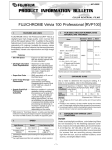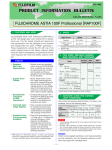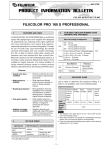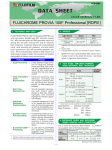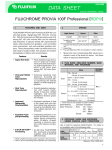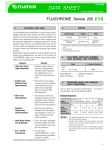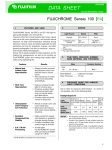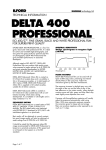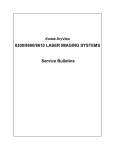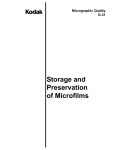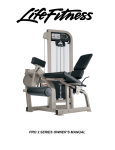Download Fujifilm 1x5 Velvia RVP 100 F 120
Transcript
AF3-148E COLOR REVERSAL FILMS FUJICHROME Velvia 100F Professional [RVP100F] 2. SPEED 1. FEATURES AND USES FUJICHROME Velvia 100F Professional [RVP100F] is an ISO 100 daylight-type color reversal film for professional use. In addition to providing the world’s highest level of color saturation and color fidelity, this film boasts a speed rating of ISO 100 and an RMS* granularity of 8, which is equivalent to that of PROVIA 100F. The result is a film that is ideally suited for a wide range of subjects which demand highly saturated colors and high image quality, from nature and landscape photography to commercial, product and interior photography. Light Source Speed Filter Daylight ISO 100/21° None Tungsten Lamps (3200K) ISO 32/16°* No.80A** (LBB-12***) * Indicates the effective speed resulting from designated filter use. ** Wratten Filter *** Fuji Light Balancing Filter (not available in certain markets.) 3. FILM SIZES, EMULSION NUMBER, BASE MATERIAL AND THICKNESS Features • ISO 100 Speed Base Emulsion Base Number Material Thickness Sizes • ISO speed rating of 100 for wide applicability, as well as the world’s highest level of color saturation and an RMS granularity of 8 • Rolls* 135 .... 36-exp. .... 36-exp. (5-roll and 20-roll packs) 35 mm × 30.5 m (100 ft.) • Color • New cyan, magenta, and Reproduction yellow couplers providing the with Ultra-high world’s highest color saturaColor Saturation tion level 120 .... 12-exp. .... 12-exp. (5-roll packs) 220 .... 24-exp. (5-roll packs) 127 µm 98 µm • Sheets* 4 × 5 in. (10.2 × 12.7 cm) .... 10 sheets and 50 sheets 8 × 10 in. (20.3 × 25.4 cm) .... 10 sheets and 50 sheets 9 × 12 cm ............... 10 sheets 13 × 18 cm ............. 10 sheets QuickLoad 4 × 5 in. .. 20 sheets • World’s Highest • World’s highest level of color Level of Color fidelity thanks to newly develFidelity oped technologies, enabling the reproduction of subtle colors beyond the capability of past films, including cyan blue, blue green, yellow green, lemon yellow, purple, and moss green Cellulose Triacetate #401 – Polyester 175 µm * Some sizes are not available in certain markets. • Super-fine Grain • RMS granularity of 8, one of the finest level equivalent to that of PROVIA 100F 4. EXPOSURE GUIDE FOR VARIOUS LIGHT CONDITIONS Use a meter for exposure determination. If a meter is not available, refer to the following table. • Improved Color • New couplers incorporated for sharply improved color image Image Stability stability (anti-fading characteristics) compared with existing reversal films Light Conditions • Excellent Push-/ • Push-/Pull-processing from -1/2 stop up to +1 stop with Pull-processing minimal changes in color Suitability balance and gradation, and even up to +2 stops (EI 400), depending on the subject, allowing easy and precise correction of exposure and density, and providing support for a wide range of shooting situations Lens Aperture Seashore or Cloudy Snow Scenes Bright Hazy Cloudy Day or under Bright Sunlight Sunlight Bright Open Sun Shade f/16 f/11 f/8 f/5.6 f/4 (Exposure time: 1/250 sec.) NOTES • The foregoing settings are for 2 hours after sunrise and 2 hours before sunset. • Provide a lens opening 1/2-stop smaller during the summer and 1/2-stop larger during the winter (except for snow scenes). • Excessively bright (or dark) or backlighted subjects may require plus (or minus) 1-stop lens opening adjustments. Daylight Under normal daylight conditions, color balancing filters are not necessary, but the following exposure conditions may require the indicated filters. * RMS stands for “Root Mean Square”, a widely used standard method for measuring the degree of grain in photographic film. The lower the RMS number, the smaller the apparent grain. –1– FUJIFILM PRODUCT INFORMATION BULLETIN • FUJICHROME Velvia 100F Professional [RVP100F] • A UV filter No. 2C* (SC-39 or SC-40)** or other appropriate ultraviolet absorbing filter is recommended for scenes that are shone upon by strong ultraviolet light, such as seaside locations, snow scenes, and bright distant views. High Color Temperature: Cloudy weather landscapes or portraits in open shade in clear weather. Low Color Temperature: Morning and evening twilight scenes and portraits. * ** *** **** Filter No.81A* (LBA-2)*** No.82A* or No.82C* (LBB-2 or LBB-4)*** White (W) Color Compensating Filters* 10B+5M Daylight Cool White (D) (CW) 25R Exposure +1/2 stop +1 stop Corrections** • Excessively high or low color temperatures may require the following filters and exposure corrections. Subject Conditions Fluorescent Lamp Type Warm White (WW) 15M+5B No. 80C+10M +2/3 stop +1 stop (Exposure time: 1/2 sec.) * Wratten Color Compensating Filters or Fuji Color Compensating Filters are recommended. NOTE: No. 80C is a Wratten Color Conversion Filter. ** Exposure correction values when using a filter relative to unfiltered exposure results. A “+” followed by a number indicates the required increase in lens opening. Exposure Correction +1/3 stop**** NOTES • Use a shutter speed slower than 1/30 second. • For shutter speeds of 2 minutes or more, exposure adjustments will be necessary to compensate for reciprocity law failure. +1/3 to +2/3 stop**** Wratten Filter Fuji Sharp-cut Filter Fuji Light Balancing Filter (not available in certain markets.) A “+” followed by a number indicates the required increase in lens opening. Tungsten Lamps • A Wratten Filter No.80A (or Fuji Light Balancing Filter LBB-12) is required when using 3200K tungsten lighting. A 1 2/3-stop larger lens opening is also required. • If household tungsten lighting (room lamps, etc.) constitutes the main source of illumination, in addition to the above filter a Wratten Filter No.82A (or Fuji Light Balancing Filter LBB-2) is required, plus an aperture increase of 1/3 stop (total 2 stops). Electronic Flash • Electronic flash produces light similar to daylight, so filters are not needed. However, the possibility of undesirable effects on color balance, due to various factors (differences in equipment, use duration, etc.) should be taken into consideration. Test exposures are recommended. • The use of a flash meter is advisable, but the following formula can also be used to obtain a satisfactory lens opening. Mixed Light Sources Under mixed light conditions, the basic filter configuration should suit the main light source. In the case of cameras with TTL metering, there is no need for additional exposure compensation for any CC filter(s) used. Lens Electronic Flash Guide Number (at ISO 100) Aperture = Electronic Flash-to-Subject Distance (meters or feet) (F-number) 5. LONG AND MULTIPLE EXPOSURE COMPENSATION • Set the film speed at ISO 100. Since the amount of light reflected onto the subject from surrounding surfaces will differ with the conditions, refer to the flash unit instructions. No exposure correction or color balance compensation is required for exposures within a shutter speed range of 1/4000 second to 1 minute. However, for exposures of 2 minutes or longer, ‘reciprocity law failure’-related color balance and exposure compensations are required. Daylight Photoflood / Photo-Reflector Lamps • Daylight-type photoflood or photo-reflector lamp output may be lower than that indicated by an exposure meter, so it is advisable to compensate for this by increasing exposure time or lens opening. Whenever possible, test exposures are recommended. • Other factors requiring consideration when determining the exposure time are lamp configuration, use duration and line voltage, as they may affect lamp output and color balance Exposure Time 1/4000 sec. – 1 min. 2 min. Color Compensating Filter Exposure Corrections* None 4 min. 8 min. 2.5B 2.5B 2.5B + 1/3 stop + 1/2 stop + 2/3 stop * Exposure correction values when using a filter relative to unfiltered exposure results. A “+” followed by a number indicates the required increase in the lens opening. Multiple Exposures No exposure correction or color balance compensation is required for up to four consecutive multiple exposures using an electronic flash. In the case of eight consecutive multiple exposures, a 2.5G color compensating filter is required with a 1/3- stop larger lens opening. Fluorescent Lamps • The use of the following combinations of color compensating filters is advisable when photographing under fluorescent lighting. • For exacting work, however, test exposures are recommended because lamp brand and age may affect light output and color balance. NOTE –2– Exposure correction values given above for long and multiple exposures are for a reversal film with an average emulsion when processed under standard processing conditions. Therefore, use the data only as a guide. For exacting work, test exposures are recommended under actual shooting conditions. FUJICHROME Velvia 100F Professional [RVP100F] • FUJIFILM PRODUCT INFORMATION BULLETIN • Before use, films taken from cold storage should be allowed to stand at room temperature for over 3 hours for refrigerated film, and over 6 hours for frozen film. Long rolls such as 100 feet (30.5 m) will require additional time. Opening a package/box of film that is cold may cause harmful condensation. 6. EXPOSURE PRECAUTIONS With artificial light, such as electronic flash, photoflood, fluorescent, tungsten, high intensity discharge lamp (metal halide, sodium, mercury vapor), etc., the lamp output and color temperature may be affected by such factors as brand, age of equipment and line voltage. Reflectors and diffusers can also influence light intensity and color temperature. Processed Film As with materials used in other products, the materials used in photographic products will change over time. Since film is usually used for the long-term recording of memorable events, as much effort as possible is made to use materials that exhibit the least amount of change over time, but the effects of light, heat, oxygen in the air, contaminating gases, humidity and mold cannot be completely avoided. It is possible, however, to minimize the change in the photographic image or base material*1 by maintaining the appropriate storage conditions for films, such as those used by museums and art galleries. Temperature and humidity control is the most important key to minimizing the change that occurs in film. Films stored in the dark under the following conditions*2 may be expected to show almost no change over time. 7. FILM HANDLING • Expose film before the expiration date indicated on the film package and process as soon as possible after exposure. • When loading and unloading roll film, avoid direct sunlight. If there is no shade, shield the film from the sun with your body. • Camera-loaded film should be exposed and processed immediately. • Handle sheet film in total darkness. Avoid touching the emulsion surface. (The use of a safelight will cause fogging.) • At airport and other terminals, unprocessed film should be kept away from X-rays used to inspect checked-in baggage. Strong X-rays can cause fogging of unprocessed film. Always place such film in your carry-on baggage. (It is recommended that film be placed in transparent plastic bags or net bags through which the film is visible.) Film which may be subjected to multiple X-ray inspections should be removed from carry-on baggage for visual (manual) inspection instead. • Film fogging may occur near X-ray equipment used in hospitals, factories, laboratories and other locations. Always keep film away from possible sources of radiation. *1 *2 Storage Period with Almost No Change: More than 20 years, Temperature: Below 10°C, Relative Humidity: 30% – 50% Ï Storage Period with Almost No Change: 10 – 20 years, Temperature: Below 25°C, Relative Humidity: 30% – 50% Ï Changes in the photographic image or base material generally take the form of reduced image quality (color fading). In some cases, however, damage to the base material may be caused by chemical changes that occur in the product when placed in a closed environment under hot and humid conditions. For the conditions indicated above, a well-ventilated place is the ideal; however, since containers prevent the passage of air, it is recommended that films be removed from containers and ventilated about once a year. Ventilation should be done during seasons in which the air is dry. Color reversal film should either be mounted or inserted into sleeves. 8. FILM STORAGE 9. PROCESSING Unprocessed Film This film is designed for processing by Kodak Process E-6, or Fujifilm Process CR-56, etc. • Storing exposed or unexposed film under hot and humid conditions may adversely affect the speed, color balance and physical properties of the film. Store film under the following conditions. 10. LIGHT SOURCES FOR VIEWING Short-to-medium-term Storage: Below 15°C (59°F) ...... (Refrigerator) Ï Long-term Storage: Below 0°C (32°F) ........ (Freezer) Ï Use a standard transparency viewer. Visual responses will differ with light source quality and brightness. Therefore, employ a viewer which meets the ISO/ANSI standard. • Building materials, finishes used on newly manufactured furniture, paints and bonding agents may produce gases which could affect photographic film. Do not store film, lightproof boxes of film, loaded cameras or film holders near these materials. * The ISO standard (ISO/DP3664-2) specifies an illuminated viewer surface with a color temperature derived from a CIE illuminant D50 (D:Daylight) with a reciprocal color temperature of 5000K, an average brightness of 1400cd/m² ± 300cd/m², a brightness uniformity of more than 75%, a light diffusion level of more than 90% and an average color rendition assessment value of more than Ra90. Transparency viewers should meet these standards. –3– FUJIFILM PRODUCT INFORMATION BULLETIN • FUJICHROME Velvia 100F Professional [RVP100F] 11. PRINTS AND DUPLICATES 12. RETOUCHING AND BLEACHING This film can produce high-quality prints when used with digital printers such as the Fuji Digital Minilab Frontier. High-quality duplicates can be made on FUJICHROME DUPLICATING FILM New CDU TYPE II (New CDU II). Changes in density and color balance can be made by using readily available retouching dyes. In regard to bleaching, this film is more resistant to color dye fading as compared with existing reversal films, as a result of its improved color image stability (anti-fading characteristics). 13. PACKAGING Size 135 120 Item Contents Film Box New Exclusive Design Identification Color: Violet Blue Plastic Case Same as the current product (Transparent container with a black cap). Cartridge New Exclusive Design Identification Color: Violet Blue Film Box New Exclusive Design Identification Color: Violet Blue 5-roll pack Envelope VELVIA 100F printed on aluminum envelope –4– FUJICHROME Velvia 100F Professional [RVP100F] • FUJIFILM PRODUCT INFORMATION BULLETIN Size 120 Item Backing Paper and Seal Contents Backing paper: FUJICHROME Exclusive Design Seal: Exclusive Design Backing Paper Top Seal 220 Film Box End Seal New Exclusive Design Identification Color: Violet Blue 5-roll pack Envelope VELVIA 100F printed on aluminum envelope Backing Paper and Seal Backing paper: FUJICHROME Exclusive Design Seal: Exclusive Design Backing Paper Top Seal Sheet Film Box, Label and Seal New Exclusive Design Identification Color: Violet Blue 14. SHEET FILM CODE NOTCHING A notch code identifying this emulsion type is located in the upper right-hand corner when the emulsion surface is facing toward you. The same notch is provided for QuickLoad type films. –5– End Seal FUJIFILM PRODUCT INFORMATION BULLETIN • FUJICHROME Velvia 100F Professional [RVP100F] 15. PROCESSED FILM EDGE MARKINGS* <Rolls> • 135 Size Quality Assurance Code** • 35 mm × 30.5 m (100 ft.) • 120 Size • 220 Size Emulsion Number Film Designation Emulsion Number Film Designation Quality Assurance Code** Film Designation Emulsion Number Quality Assurance Code** Quality Assurance Code** Film Designation Emulsion Number <Sheets> • Standard Sheet Film • QuickLoad * The emulsion is on the opposite side. (Base side facing you) ** This code represents an identification marking enabling Fujufilm’s manufacturing quality control system to assure individual quality. –6– FUJICHROME Velvia 100F Professional [RVP100F] • FUJIFILM PRODUCT INFORMATION BULLETIN auxiliary absorptive components (which cause muddiness) and provide high color stability. 16. TECHNOLOGIES INCORPORATED IN VELVIA 100F 16-2 MCCL (Multi-Color-Correction Layer) Technology Not only has the spectral sensitivity of the three lightsensitive layers (R, G, B) been optimized, “4th Color Layer (Green-Color-Correction Layer)” has been incorporated that performs the “negative spectral sensitivity” function of the human eye. Additionally, in order to enable more appropriate color reproduction with a higher level of fidelity, Velvia 100F has incorporated MCCL Technology, as an extension of “4th Color Layer Technology”. This new technology has provided “Red-ColorCorrection Layer (5th Color Layer)”, and “Blue-ColorCorrection Layer (6th Color Layer)” to allow this film to reproduce complex colors of the natural world with high faithfulness. 16-1 PSHC (Pure, Stable & High-performance dye-forming Coupler) Technology The new couplers used in Velvia 100F provide it with high color purity, stability and color formation efficiency, making possible color reproduction with unprecedented fidelity and excellent image stability. This vividness forms the basis for Velvia 100F’s ability to reproduce colors with ultra-high saturation. a) X-Coupler Technology: This marks the first use in color reversal film of Fujifilm’s new proprietary cyan coupler. b) V-Coupler Technology: New technologies have been incorporated with the V-coupler applied in Fujifilm’s color papers and other products to vastly improve color reproduction and stability. The result is the new magenta coupler that is incorporated in reversal films for the first time. c) S-Coupler Technology: In place of the yellow coupler used in FUJICHROME films providing these films with Fujifilm’s trademark color reproduction and stability, a new yellow coupler has been incorporated to further boost these characteristics to even higher levels. Compared with existing FUJICHROME films, the X, V and S couplers have resulted in a drastic reduction in 16-3 MSSC (Multi-Structured Sigma Crystal) Technology This technology is incorporated in Velvia 100F to improve upon the highly acclaimed ultra-fine grain emulsion technology used in PROVIA 100F, resulting in a greater enhancement in grain quality. With this technology as a basis, Velvia 100F continues to provide ultrahigh color saturation along with super-fine grain quality (RMS=8) and high sensitivity (ISO 100) that exceed the levels of the current ISO 50 Velvia. 17. FILM STRUCTURE Before Processing After Processing Protective Layer Blue Sensitive Layer (containing Colorless Yellow Coupler) Yellow Positive Image Blue-Color-Correction Layer (6th Color Layer) Yellow Filter Layer* Green Sensitive Layer (containing Colorless Magenta Coupler) Magenta Positive Image Red Sensitive Layer (containing Colorless Cyan Coupler) Cyan Positive Image Red-Color-Correction Layer (5th Color Layer) Green-Color-Correction Layer (4th Color Layer) Antihalation Layer* : Silver Halide : Coupler : Processing-induced Dye Safety Film Base Backing Layer** * These layers become colorless and transparent after processing. ** The backing layer becomes colorless and transparent after processing, but it is not provided with 135 size film. 18. DIFFUSE RMS GRANULARITY VALUE ................. 8 19. RESOLVING POWER Chart Contrast Chart Contrast Read at a gross diffuse visual density of 1.0, using a 48micrometre aperture. –7– 1.6 : 1 .......................... 80 lines/mm 1000 : 1 ........................ 160 lines/mm FUJIFILM PRODUCT INFORMATION BULLETIN • FUJICHROME Velvia 100F Professional [RVP100F] 20. CHARACTERISTIC CURVES 21. SPECTRAL SENSITIVITY CURVES 4.0 Exposure : Daylight, 1/50 sec Process : E-6/ CR-56 Densitometry : Fuji FAD-30S (Status A) 3.5 1.0 Sensitivity* (log) 2.5 2.0 1.5 1.0 Red Green Blue 0.5 0.0 -3.0 0.0 -1.0 0.0 1.0 Red Sensitive Layer Process : E-6/ CR-56 Densitometry : Fuji FAD-30S (Status A) Density : 1.0 above D-min –1.0 -2.0 Green Sensitive Layer Blue Sensitive Layer 400 500 Exposure [log H (lux-seconds)] 600 700 Wavelength (nm) * Sensitivity equals the reciprocal of the exposure (J/cm²) required to produce a specified density. 23. SPECTRAL DYE DENSITY CURVES 22. MTF CURVE 150 Exposure : Separated Light Process : E-6/ CR-56 100 70 50 1.0 Spectral Diffuse Density Response (%) Density (D) 3.0 30 20 10 7 5 Exposure : Daylight 3 Process : E-6/ CR-56 2 1 5 10 Yellow 0.5 0.0 20 50 100 Cyan Magenta 200 Spatial Frequency (cycles/ mm) 400 500 600 700 Wavelength (nm) NOTICE The data herein published were derived from materials taken from general production runs. However, as Fujifilm is constantly upgrading the quality of its products, changes in specifications may occur without prior notice. –8– FUJI PHOTO FILM CO., LTD. 26-30, Nishiazabu 2-chome, Minato-ku, Tokyo 106-8620, Japan Ref. No. AF3-148E (EIGI-03.5-HB•12-2!) Printed in Japan








